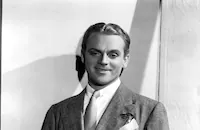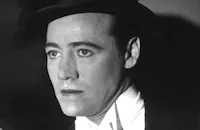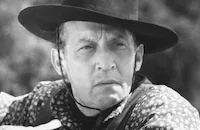Lady Killer

Brief Synopsis
Cast & Crew
Roy Del Ruth
James Cagney
Mae Clarke
Margaret Lindsay
Leslie Fenton
Douglas Dumbrille
Film Details
Technical Specs

Synopsis
While returning a purse dropped by attractive Myra Gale, Dan Quigley quickly learns that he has been the victim of a confidence game. He threatens the gang with exposure unless they cut him in on their profits. Dan works the racket so successfully that they are able to open a gambling club patronized by wealthy customers. When they spot a likely victim among the customers, Dan arranges a fake accident so he will be taken into the victim's house and cases it for his fellow gangsters. Eventually, the police suspect Dan's gang, and when someone dies during a robbery, the gang leaves town. They travel to Los Angeles, where Dan is arrested. He asks Myra to arrange his bail, but Spade Maddock, another gang member, talks her into using the money to leave town. Because they do not have enough evidence to hold Dan, the police release him. Looking like a hobo, he is offered work as a movie extra. One day, he stumbles into the dressing room of movie star Lois Underwood. He starts a self-promoting letter writing campaign, which convinces the studio that he would be a good choice for a new leading man. Dan and Lois become romantically involved, and things are going well for Dan until Myra and the gang return. They threaten to reveal his past unless he fingers wealthy Hollywood people for robberies. He refuses, paying the gang a large amount of money to leave town. They double-cross him, robbing Lois's house, and Dan is arrested. When the studio will not stand by him, Lois offers to pay his bail, but the gang beats her to it, planning to kill him before he can tell the police about their activites. Suspecting their motives, Dan tips off the police, and the gang is captured. After Dan is cleared of all charges and his career saved, he and Lois leave to get married.

Director

Roy Del Ruth
Cast

James Cagney

Mae Clarke

Margaret Lindsay

Leslie Fenton

Douglas Dumbrille

Russell Hopton

Raymond Hatton

Henry O'neill
Robert Elliott

Marjorie Gateson
Willard Robertson

William Davidson
Douglas Cosgrove
George Blackwood
John Marston
George Chandler
Dewey Robinson

James Burke
Luis Alberni
Sam Mcdaniel
Crew

Photo Collections
Film Details
Technical Specs

Articles
Lady Killer
Coming fast on the heels of James Cagney's resounding success as a singing and dancing theatrical producer in the musical Footlight Parade (1933), Lady Killer (1933) returned to the tried-and-true gangster genre in which he had made his name, this time a comedy with satirical jabs at Hollywood and the American Dream. The working title of the project was The Finger Man. Warner Brothers' title change was not without complications: playwrights Fred and Alice Mandel claimed to own the rights to the title Lady Killer for their stage play and even received a temporary injunction stopping the studio from using it. Early treatments of the film combined the tough gangster image with song-and-dance routines to capitalize on the popularity of his previous film, but this move was rejected by studio executives in favor of a more conventional image. The tap dancer of the early drafts was changed into a theater usher. Mae Clark, who had previously suffered the indignity of having a grapefruit shoved in her face in The Public Enemy (1931), returned to work with Cagney, this time to be dragged by her hair across a room and thrown out a door.
Reportedly, Cagney was frustrated by the studio-imposed gangster roles he was often required to play subsequent to his creation of the seminal figure of Tom Powers in The Public Enemy. An exceptionally intelligent and gifted actor, he longed for opportunities to demonstrate his versatility and range, including more work in the musical genre. Some have speculated that the new head of production after Zanuck's departure, Hal Wallis, was less enthusiastic about making musicals and didn't have as close a relationship with Cagney. Also, Cagney's relationship with the studio was already strained due to his two walkouts in 1931 and 1932, when he refused to work in protest of his relatively low salary and benefits, at the time a daring gesture since actors were tightly bound by studio contracts. In fact, in spite of his box-office clout, he was earning substantially less than many other stars at the same studio. His commitment to leftist politics at the time didn't help either, exasperating the conservative Jack Warner.
Although not one of Cagney's favorite films, Lady Killer was popular and critically well-received at the time of its release: a film critic in Variety wrote, "Crook angle is handled with a cheerful style of humor and there is a certain spirit about the Cagney character, played in his energetic way, that carries its own persuasive charm. Comedy is first rate."
Director: Roy Del Ruth
Producer: Henry Blanke
Screenplay: Ben Markson and Lillie Hayward
Cinematography: Tony Gaudio
Editing: George Amy
Music: Leo F. Forbstein
Costume Design: Orry-Kelly
Cast: James Cagney (Dan Quigley), Mae Clark (Myra Gale), Margaret Lindsay (Lois Underwood), Leslie Fenton (Duke), Douglass Dumbrille (Spade Maddock), Russell Hopton (Smiley).
BW-76m.
by James Steffen

Lady Killer
Quotes
Trivia
When Myra (Mae Clarke) is reading from the California travel brochure, she gets a worried look on her face when she reads "Grapefruit." This is a reference to Public Enemy, The (1931) (which also stars James Cagney and Clarke) where Cagney's character pushes a grapefruit into the face of hers.
Notes
The film's working title was The Finger Man. According to a news item in Film Daily, Patricia Ellis was to play the second female lead along with Mae Clarke. Daily Variety reports that Warner Bros. was temporarily enjoined from using the title Lady Killer. The complaint of playwrights Fred and Alice Mandel alleged that Warner Bros. was notified of prior rights to the use of the title of their stage play and that releasing the film under that title was an infringement of title rights.















